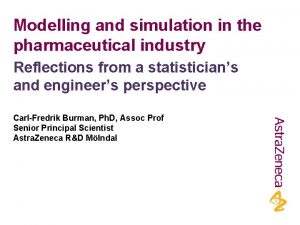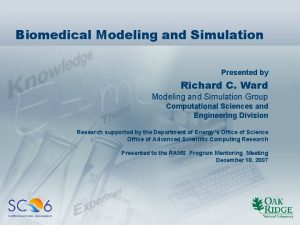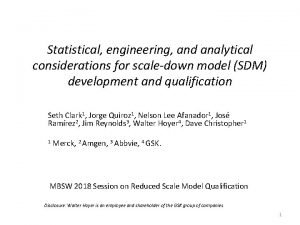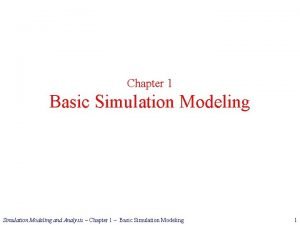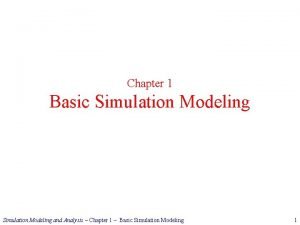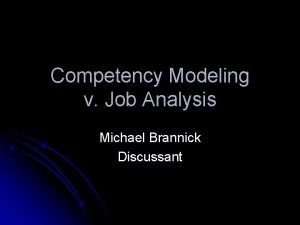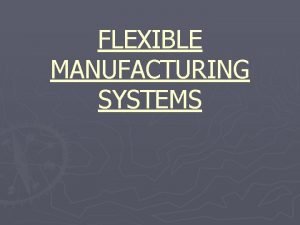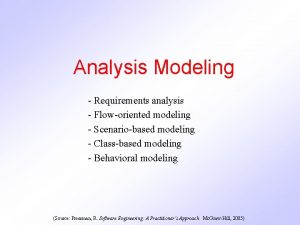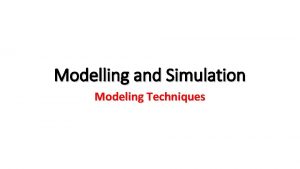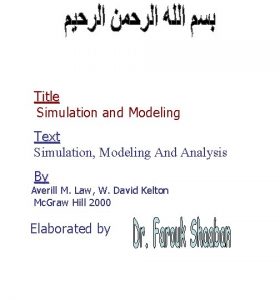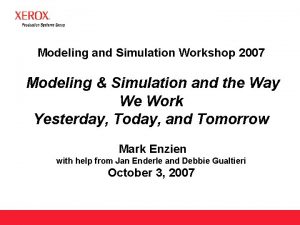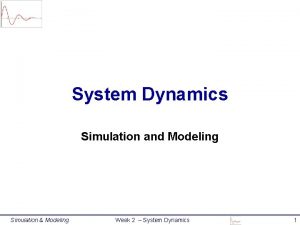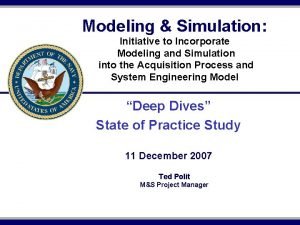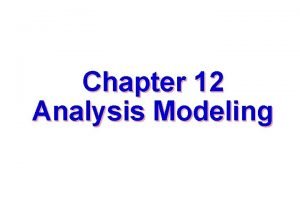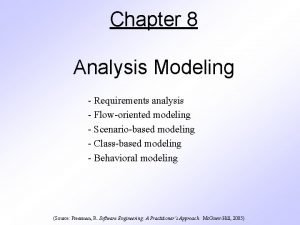Chapter 3 Simulation Software Simulation Modeling and Analysis













- Slides: 13

Chapter 3 Simulation Software Simulation Modeling and Analysis – Chapter 3 – Simulation Software 1

CONTENTS 3. 1 Introduction 3. 2 Comparison of Simulation Packages with Programming Languages 3. 3 Classification of Simulation Software 3. 4 Desirable Software Features 3. 5 General-Purpose Simulation Packages 3. 6 Object-Oriented Simulation 3. 7 Examples of Application-Oriented Simulation Packages Simulation Modeling and Analysis – Chapter 3 – Simulation Software 2

3. 1 INTRODUCTION • Activities common to most simulations: – Random-number generation … draws from U(0, 1) distribution – Random-variate generation … draws from probability distributions specified as part of the inputs to the model – Advancing simulated time – Determining the next event from the event list, and passing control to the appropriate event logic – Adding records to lists, deleting records from lists – Collecting output statistics and reporting results – Detecting error conditions • Simulation software packages are designed to do these things (and more) for you Simulation Modeling and Analysis – Chapter 3 – Simulation Software 3

3. 2 COMPARISON OF SIMULATION PACKAGES WITH PROGRAMMING LANGUAGES • Advantages of simulation packages – Provide most modeling features, so “programming” effort, cost is reduced, often significantly – Natural framework for simulation modeling – Usually make it easier to modify models – Better error detection for simulation-specific errors • Advantages of general-purpose programming languages – – More widely known, available Usually executes faster … if well written May allow more modeling flexibility Software cost is usually lower Simulation Modeling and Analysis – Chapter 3 – Simulation Software 4

3. 3 CLASSIFICATION OF SIMULATION SOFTWARE • General-purpose vs. application-oriented packages – Traditionally: simulation languages and simulators § Languages were flexible but required programming, simulators were easy to use but not very flexible – Now, almost all simulation software uses graphical interface so is relatively easy to use, learn – Distinction now is between general-purpose simulation software and applications-oriented package § Specific applications include manufacturing, call centers, telecommunications, etc. Simulation Modeling and Analysis – Chapter 3 – Simulation Software 5

3. 3 Classification of Simulation Software (cont’d. ) • Modeling approaches – Event-scheduling approach – as in Chaps. 1 and 2 § § Can uses general programming languages, or some simulation languages During processing of an event, no simulated time passes – Process-interaction approach § § § § Now used by most simulation software Instead of identifying events, identify entities (a. k. a. processes) that are created, flow around or through the system, maybe leave May have multiple realizations of an entity/process May have different kinds of entities/processes “Program” consists of a description of what happens to the different kinds of processes (including their entry and exit) Usually expressed graphically, like a flowchart During processing of an entity/process, simulated time usually passes Simulation Modeling and Analysis – Chapter 3 – Simulation Software 6

3. 3 Classification of Simulation Software (cont’d. ) • Common modeling elements – Entities – represent customers, parts, messages, paperwork, airplane, etc. – Attributes – Information stored with each entity § § Usually, every individual entity has the same set of attributes, but the values differ to distinguish the entities Some attributes are automatic, others are user-defined and user-maintained – Resources – servers, machines, workers, nodes, links, runways, gates, agents, clerks, etc. – Queues – where entities wait if resources are not available Simulation Modeling and Analysis – Chapter 3 – Simulation Software 7

3. 4 DESIRABLE SOFTWARE FEATURES • General capabilities – Modeling flexibility – ability to drill down to lower levels of programming, create custom modeling constructs – Ease of use – Hierarchical modeling – submodels containing submodels, etc. – Fast execution speed – Ability to create user-friendly front/back ends for template creation – Run-time version for wide distribution of model – Import/export data from/to other applications – Automatic execution of models for different input-parameter combinations – Combined discrete/continuous modeling – Ability to initialize in other than empty & idle state – Save state at end to re-start later – Affordable Simulation Modeling and Analysis – Chapter 3 – Simulation Software 8

3. 4 Desirable Software Features (cont’d. ) • Hardware and software requirements – Matches platform/OS – Windows, UNIX, Mac. OS • Animation and dynamic graphics – – Concurrent vs. postprocessing 2 D vs. 3 D Import CAD drawings Display statistics, graphs dynamically during execution Simulation Modeling and Analysis – Chapter 3 – Simulation Software 9

3. 4 Desirable Software Features (cont’d. ) • Statistical capabilities – Adequate random-number generator for basic U(0, 1) variates § § Statistical properties, cycle length, adequate streams and substreams RNG seeds should have good defaults, be fixed – not dependent on clock – Comprehensive list of input probability distributions § – – – Continuous, discrete, empirical Ability to make independent replications Confidence-interval formation for output performance measures Warmup Experimental design Optimum-seeking • Customer support and documentation • Output reports and graphics – Standard defaults, customizable – stored in database for postprocessing Simulation Modeling and Analysis – Chapter 3 – Simulation Software 10

3. 5 GENERAL-PURPOSE SIMULATION PACKAGES • See text for discussion of two popular general-purpose simulation packages – Arena and Extend – In each, builds a model of a small manufacturing system • Mentions some additional general-purpose simulation packages – Awe. Sim, Micro Saint, GPSS/SLX, SIMPLE++, SIMUL 8, Taylor Enterprise Dynamics Simulation Modeling and Analysis – Chapter 3 – Simulation Software 11

3. 6 OBJECT-ORIENTED SIMULATION • OO programming and OO simulation originated in the same product – SIMULA, from the 1960 s • OO simulation has objects that interact as simulation progresses through simulated time • Objects contain data, methods • Also have encapsulation, inheritance, etc. • Recent software product for OO simulation – MODSIM III Simulation Modeling and Analysis – Chapter 3 – Simulation Software 12

3. 7 EXAMPLES OF APPLICATIONORIENTED SIMULATION PACKAGES • Oriented toward specific classes of applications – see book for software packages for: – – – Manufacturing Communications Process reengineering and service systems Health care Call centers Standalone animation – links to multiple simulation-modeling packages Simulation Modeling and Analysis – Chapter 3 – Simulation Software 13
 Simulation modeling and analysis law kelton
Simulation modeling and analysis law kelton Model and role modeling theory
Model and role modeling theory Relational vs dimensional data modeling
Relational vs dimensional data modeling Pharmaceutical simulation and modeling
Pharmaceutical simulation and modeling Introduction to modeling and simulation
Introduction to modeling and simulation Biomedical modeling and simulation
Biomedical modeling and simulation Pengertian pemodelan dan simulasi
Pengertian pemodelan dan simulasi Modeling and simulation
Modeling and simulation Basic simulation modeling
Basic simulation modeling Basic simulation modeling
Basic simulation modeling Dfd chapter 5
Dfd chapter 5 System requirements checklist output example
System requirements checklist output example Competency model vs job analysis
Competency model vs job analysis Manufacturing systems modeling and analysis
Manufacturing systems modeling and analysis



